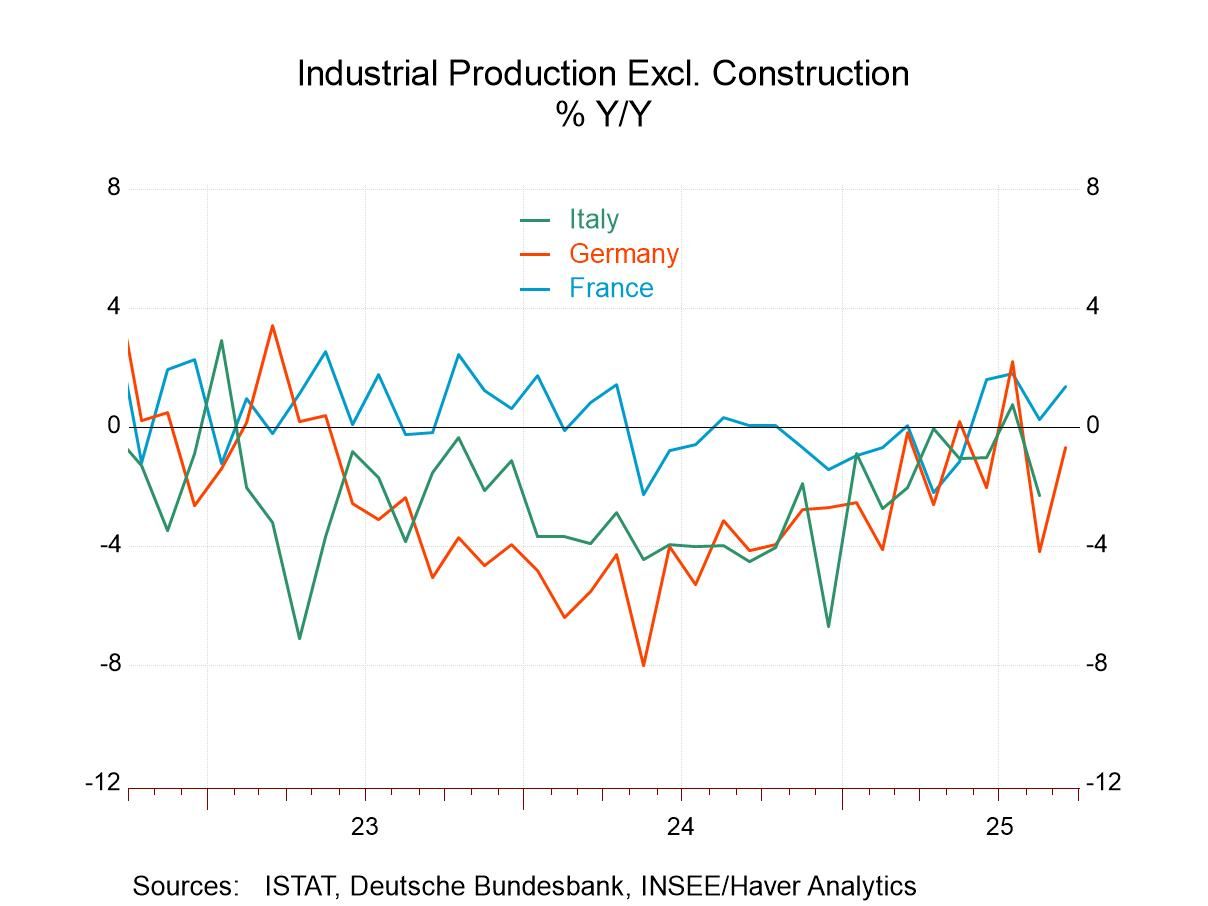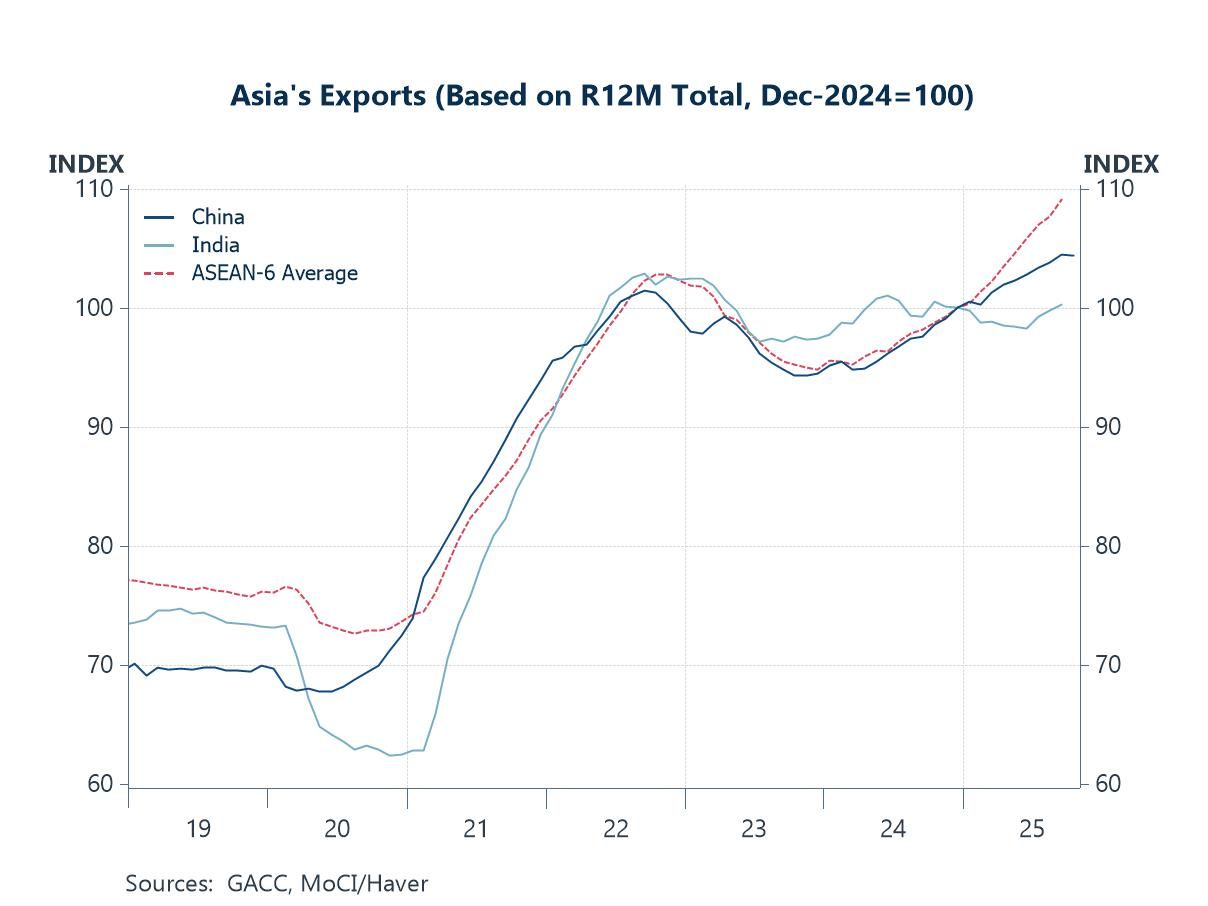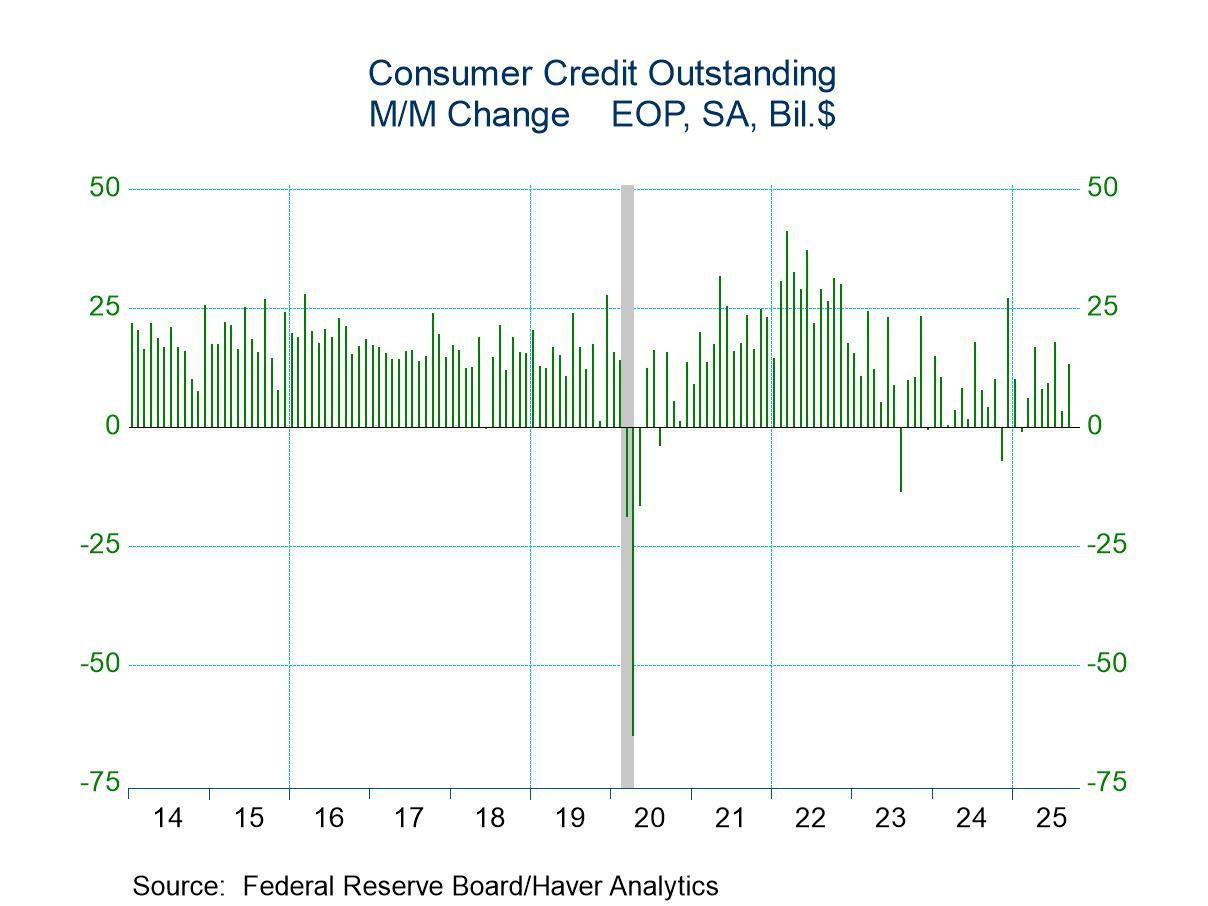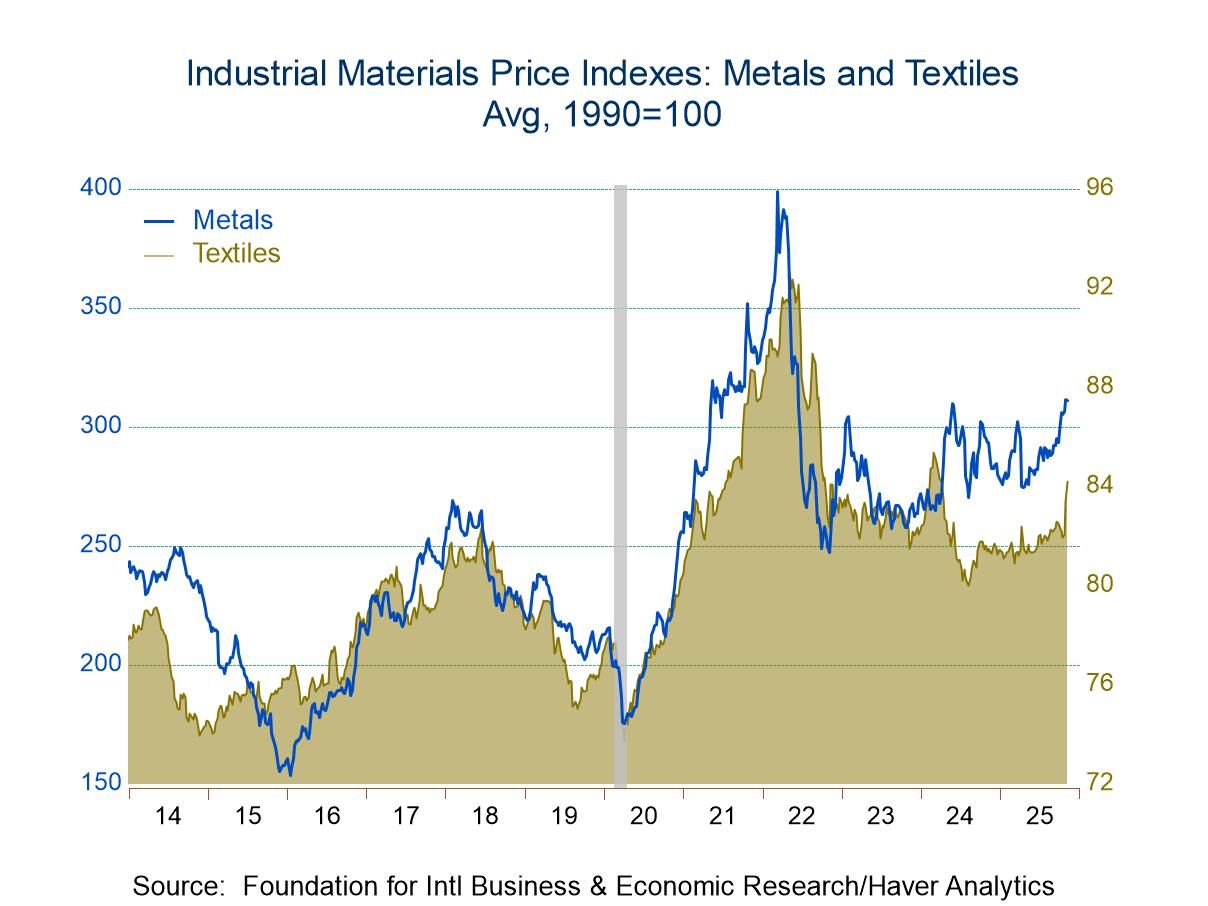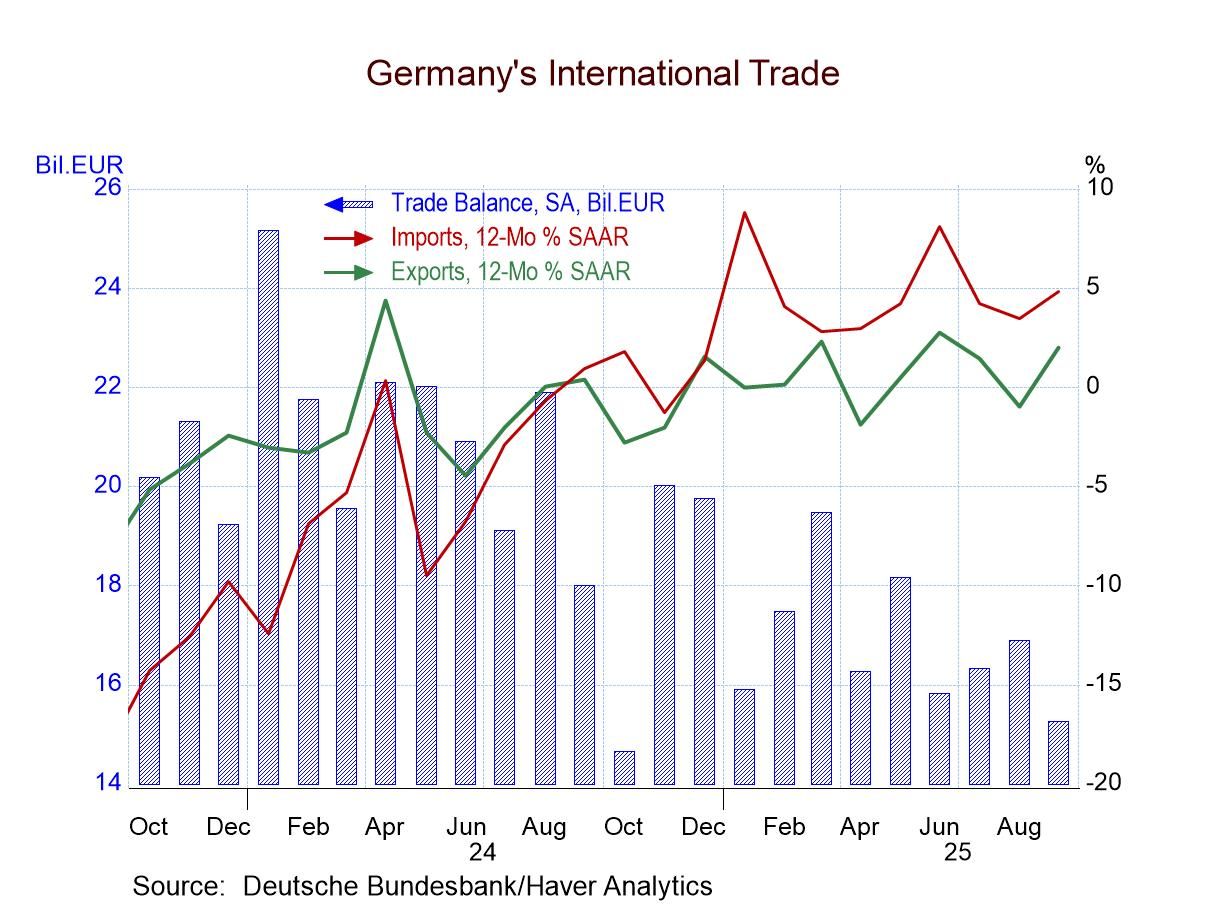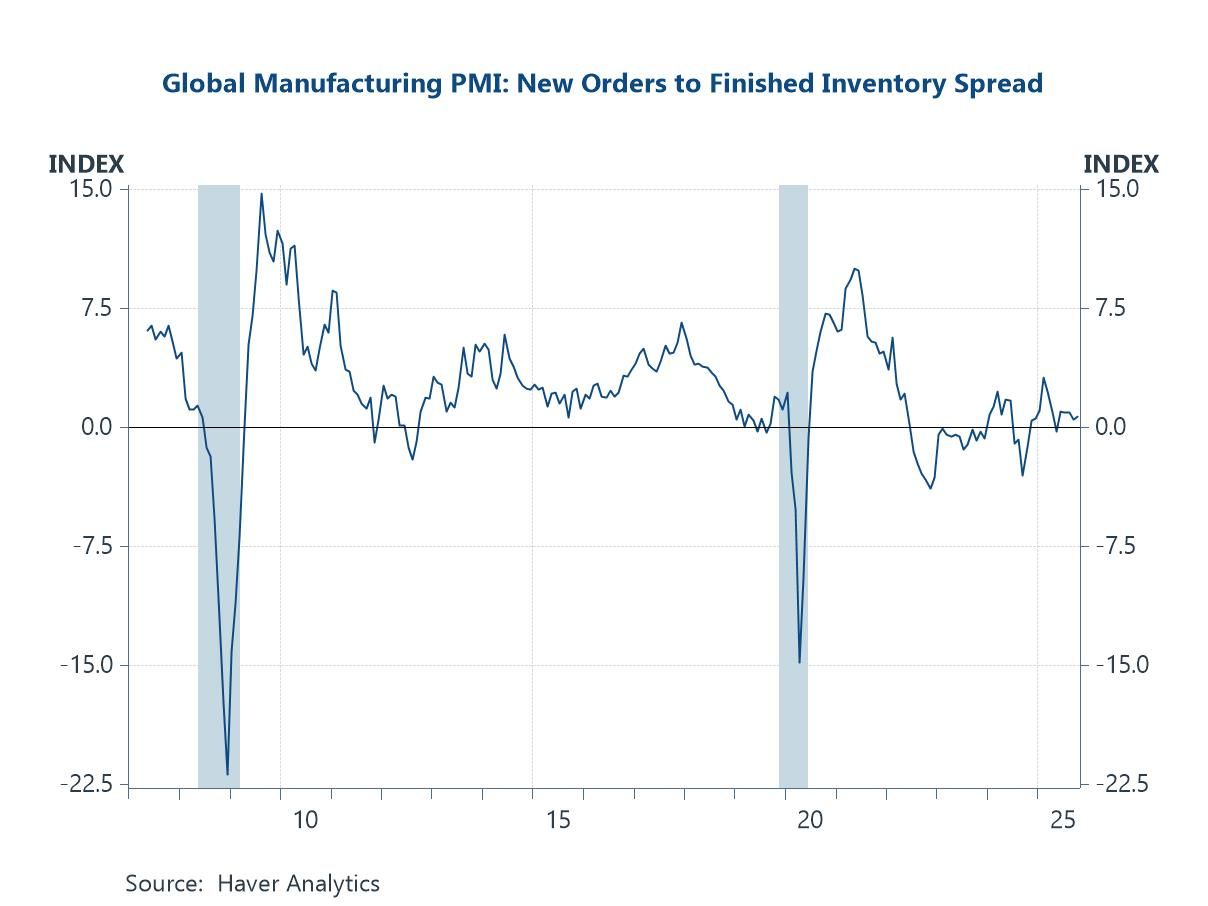- Increase in initial claims reverses most of earlier decline.
- Continuing claims continue to increase.
by:Tom Moeller
|in:Economy in Brief
- Europe| Nov 10 2025
Production in a Gradual Recovery in Europe Despite Recent Setbacks
Industrial production for the European Monetary Union (EMU) is not yet available for the union as a whole; however, a number of European countries have reported production, and they give us a good sense of what's happening. In September, among the 13 European countries that reported in the table, all but four of them showed increases in industrial production. Declines were posted in Ireland where production fell by 9.4% in one month, Luxembourg where it fell by 6.1%, Malta where it fell by 1.7%, and in Finland where it fell by 0.4%. In the remaining nine countries, production increased. The median increase for monetary union members in the table was a rise of 0.8% month-to-month. 45.5% of the reporters in the monetary union showed production acceleration.
In August, there were 5 European members with production decreasing. Among European Monetary Union members, the median was a decline of 0.5% with 46.2% of the reporters showing output accelerating on the month. July had been a much worse month with 8 reporting European countries showing declines and with the monetary union median showing a decline of 0.3% and only 38.5% of the reporting EMU members showing output accelerating month-to-month.
There has been gradual moderate improvement in these monthly statistics both in terms of improvement in the median and improvement in the breadth as output has accelerated, with a step back in August.
Looking at the sequential data that compare three-month results to six-month results to 12-month results, we see a median annualized increase of 2.9% for output across monetary union members over three months; that's up from 0.8% over six months and compares to a 2.1% increase for monetary union members over twelve months. The breadth of increase over the period is above 50% on all the horizons and it's fairly steady over three months and six months at about a 54-percentile standing.
September data conclude the results for the third quarter. In this quarter-to-date calculation, 6 of the 13 reporters in the table shows output declining in the third quarter. Monetary Union members generate a median increase of 0.3% in terms of annualized quarter-to-quarter industrial output changes. The pattern and the monthly data seem to be slightly stronger than what we see in the quarter-to-date.
The final column of the table presents the queue standings that calculate the positioning of the year-over-year growth rates across country-reporters among growth rates back to late-2007. Ranked among this cluster of growth rates, only five of the current year-over-year rates stand at levels that are below their median growth rate for the period. Countries with below median growth rates (below a standing of 50%) for industrial production growth are Austria, Germany, Finland, Luxembourg, and Malta. Among these, only one belongs to the four largest economies in the monetary union—Germany, which is also the largest of them. Germany has the standing only its 39th percentile. The unweighted median ranking for the group of monetary union economies is at 57.3%, above the 50% mark and therefore above the historic median.
The industrial production data for the monetary union in September is somewhat encouraging but certainly not crystal clear. There continues to be a lot of weaknesses displayed in the data. While the aggregate ranking is above its historic median, it's not above it by very much and clearly the growth rates are still relatively weak. There still is not a clear trend of acceleration in the group. However, what's lacking in the data is any sign of real deterioration. There clearly is weakness across countries but not a sense of deterioration. The best news in the report may be that there's not any really bad news.
 Asia| Nov 10 2025
Asia| Nov 10 2025Economic Letter from Asia: As the Dust Settles
This week, we review key developments across several Asian economies as the year nears its close. On balance, many of investors’ and policymakers’ worst fears did not materialize. Despite US tariffs, regional exports have shown resilience (chart 1), partly supported by stronger intra-Asia trade, even as exports to the US declined in some cases.
In China, factors including importer front-loading, stronger exports to non-US markets, and government efforts to boost consumption—albeit with potentially one-off effects—have kept the economy on track to meet its 5% growth target this year (chart 2), barring a substantial slowdown in Q4. In Japan, political uncertainty has eased following Prime Minister Takaichi’s rise, though her pro-growth, pro-loose monetary stance has contributed to further yen weakness (chart 3). India, while still likely Asia’s fastest-growing major economy this year, has seen trade setbacks (chart 4) as US–India discussions continue, though recent progress suggests a deal may be near.
However, not all developments in Asia have avoided worst-case outcomes. For example, the Philippines, which has already been hit by a string of storms this year, continues to reel from the effects of Typhoons Fung-wong and Kalmaegi. These storms have highlighted corruption in the Philippines’ flood control systems, rattling investors and pressuring the peso (chart 5), in a manner reminiscent of the rupiah’s decline during Indonesia’s political turmoil earlier this year. In Thailand, political uncertainty continues ahead of general elections eyed at next March, while the expected full return of Chinese tourists has yet to materialize (chart 6).
Trade in Asia For Asia, the year has ultimately not played out as bleakly as investors once feared, particularly on the trade front. Despite US President Trump’s tariffs and a persistent backdrop of uncertainty, export performance in several Asian economies has proven more resilient than expected. This is most clearly reflected in export growth readings for China and key Southeast Asian economies (chart 1), which have remained firm—and at times exceeded expectations—even as China’s shipments to the US fell sharply. Much of this resilience reflects a redirection of exports toward other markets, often within the region. India, however, has seen more limited gains, with exports in US dollar terms struggling to materially surpass last year’s levels.
- USA| Nov 07 2025
U.S. Consumer Credit Strengthens in September
- Notable gain in credit usage follows prior month’s slowdown.
- Nonrevolving credit usage strengthens and revolving turns positive.
by:Tom Moeller
|in:Economy in Brief
- Textile and metals prices strengthen.
- Framing lumber costs plummet.
- Crude oil prices weaken.
by:Tom Moeller
|in:Economy in Brief
- Germany| Nov 07 2025
German Trade Surplus Shrinks Despite Strong Exports
The chart provides a good overview for German trade trend. The table breaks trade trends down by categories and provides growth rates on shorter horizons of 3 months, 6 months and 12 months. But the chart depicts the overarching trends well. It shows the German surplus being diminished on a gradual path and not altogether in a clear monotonic fashion. Export and import lines on the chart move mostly sideways (horizontal). The export line is below the import line since late last year. These two series plots on the right-hand scale and they depict growth rates (year-over-year). So sideways movements mean roughly steady growth. Exports have been growth steadily year-over-year at a weak pace that on occasion has been a decline in terms of their year-on-year value. Generally, the green line is in positive territory. The red import line has been stronger, indicating somewhat better, steadier import growth over the period.
While exports had a good September, export growth sequenced from 12-months to 6-months, to 3-months has been weakening. Imports also put in a strong September but are showing some erosion from 12-month to 6-months to 3-months in terms of annualized rates of growth. Still, import growth rates remain quite strong and consistent; the sense of erosion is clear but also moderate – it’s a moderate erosion in progress for imports.
Capital goods exports from Germany are improving- this observation is based on lagged data with a one-month lag built in. But consumer goods and vehicle exports are slowing and rather sharply- likely as a result of U.S. tariffs.
Import side trends, with the same lag, are not as clear cut. Capital goods imports are growing, and motor vehicle imports are improving and accelerating. Consumer goods imports have erratically slowed.
Real exports and imports on sequential lagged data show exports contracting on most horizons while imports generate consistent positive growth in real terms. There is a big difference in these two trends expressed in real terms.
On balance, German trade trends are shifting. The trade balance is gradually eroding. Change is in play.
 Global| Nov 06 2025
Global| Nov 06 2025Charts of the Week: Uneven But Unbroken
Recent financial market developments have been shaped by a renewed bout of volatility, with heightened concerns about stretched AI valuations triggering a big correction across parts of the tech sector. This comes against a backdrop of lingering uncertainty in Washington, where the US government shutdown has continued to delay the release of several key economic reports, clouding visibility on near-term momentum. Still, the broader macro signals offer a mixed but nuanced picture. Global manufacturing PMIs have continued to hold up, hinting that underlying industrial momentum remains resilient (chart 1). The latest US Senior Loan Officer Survey points to a stabilisation in credit conditions—banks remain cautious, but the most intense phase of tightening may have now passed (chart 2). In China, the October PMIs reflected renewed softness in manufacturing alongside a still-steady services sector, tentatively suggesting that growth may be rebalancing, albeit at a weaker aggregate pace of growth (chart 3). Australia’s inflation and labour market data, meanwhile, have complicated the case for near-term policy easing, with the RBA opting to stay on hold this week as core inflation remain sticky. In Argentina, currency weakness persists even as equity markets rally, highlighting the policy and market tension surrounding President Milei’s reform agenda (chart 5). And finally, at a more structural level, latest global emissions data serve as a reminder that energy, manufacturing, transport, and households remain the principal sources of CO₂—illustrating how the climate and energy transition will continue to shape the macro landscape well beyond the current economic cycle (chart 6).
by:Andrew Cates
|in:Economy in Brief
- Decline in initial claims reverses earlier gain.
- Continuing claims move higher.
- State unemployment rates vary.
by:Tom Moeller
|in:Economy in Brief
- of98Go to 7 page



